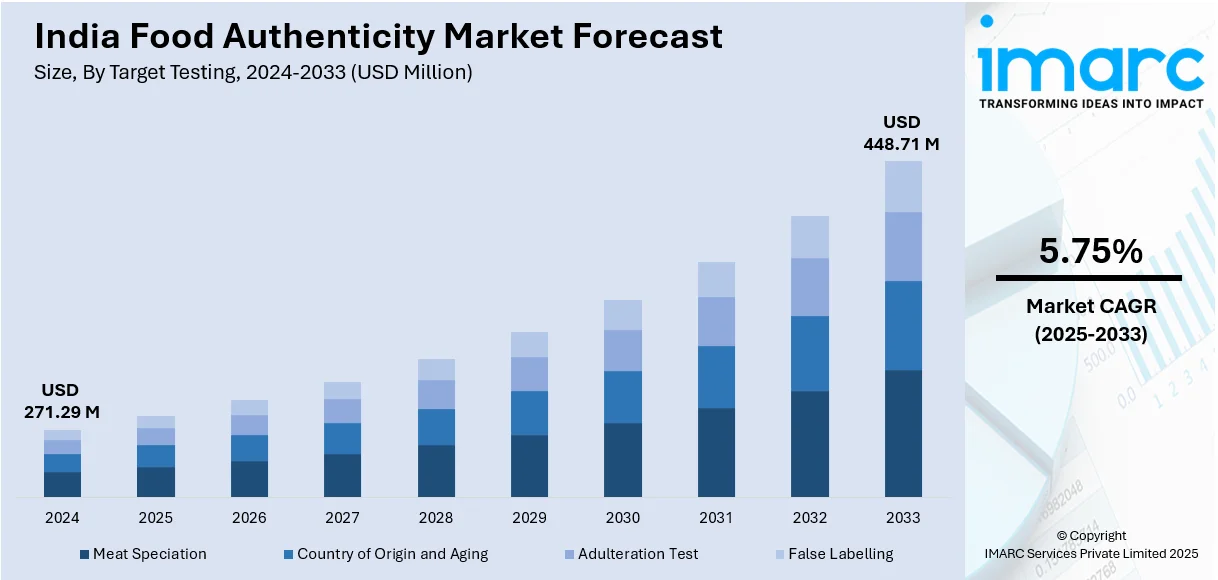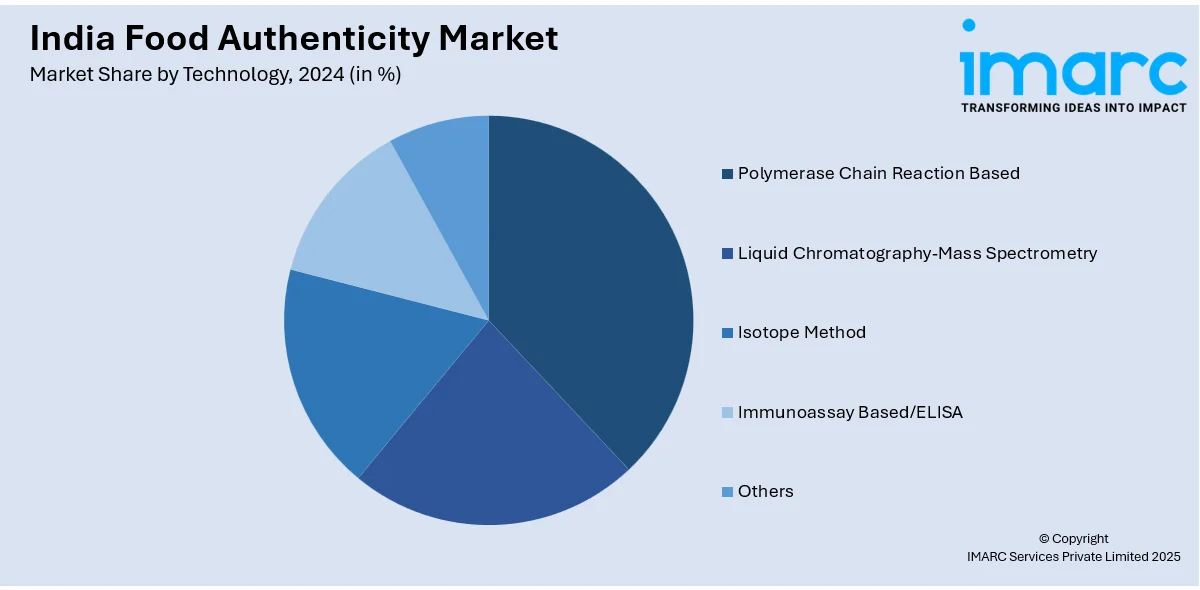
India Food Authenticity Market Size, Share, Trends and Forecast by Target Testing, Technology, Food Tested, and Region, 2025-2033
India Food Authenticity Market Size and Share:
The India food authenticity market size reached USD 271.29 Million in 2024. Looking forward, IMARC Group expects the market to reach USD 448.71 Million by 2033, exhibiting a growth rate (CAGR) of 5.75% during 2025-2033. The India food authenticity market share is driven by rising food adulteration cases and mislabeling and expanding packaged food demand, which increases authenticity verification needs. Besides this, the growing consumer awareness is improving transparency expectations, while technological advancements in testing methods are enhancing food safety and quality assurance.
|
Report Attribute
|
Key Statistics
|
|---|---|
|
Base Year
|
2024
|
|
Forecast Years
|
2025-2033
|
|
Historical Years
|
2019-2024
|
| Market Size in 2024 | USD 271.29 Million |
| Market Forecast in 2033 | USD 448.71 Million |
| Market Growth Rate (2025-2033) | 5.75% |
India Food Authenticity Market Trends:
Increasing Incidents of Food Adulteration and Mislabeling
Increasing incidents of food adulteration and mislabeling are strengthening the India food authenticity market growth. Consumers are facing rising health risks due to harmful chemicals and contaminants present in food products. Authorities are enforcing stricter food safety regulations to curb fraudulent practices and ensure consumer protection. In September 2024, the Food and Drug Administration (FDA) in Pune conducted a special drive during the Ganesh Festival, seizing suspected adulterated and substandard food items worth ₹14.35 lakh. The inspection covered Pune, Solapur, Satara, Sangli, and Kolhapur, focusing on milk, khoya, paneer, mawa, ghee, butter, and namkeen, highlighting the growing concerns over food safety. Additionally, manufacturers are increasingly investing in advanced testing solutions to detect adulterants and verify ingredient authenticity effectively. Food authenticity testing is gaining prominence as businesses strive to maintain consumer trust and brand reputation. The government is implementing stricter penalties and monitoring systems to deter food adulteration practices nationwide. Laboratories and research institutions are developing innovative testing technologies to enhance accuracy and efficiency in food authentication. The increasing penetration of counterfeit food products in the market is further improving demand for authenticity testing solutions, making food safety a growing priority across the industry.

To get more information on this market, Request Sample
Expansion of Packaged Food Industry
The expansion of the packaged food industry is significantly influencing the India food authenticity market outlook. The escalating consumer demand for convenience foods is increasing the need for strict quality control and authenticity verification. As per the data published by IMARC Group, the India packaged food market is expected to reach US$ 210.81 Billion by 2032, exhibiting a CAGR of 7.08% during 2024-2032. With this rapid growth, packaged food products are becoming more susceptible to adulteration, mislabeling, and counterfeiting, requiring advanced authentication techniques for safety. Manufacturers are increasingly investing in food authenticity testing to comply with regulatory standards and maintain brand credibility. Moreover, growing urbanization and changing lifestyles are further driving the consumption of packaged foods, intensifying concerns over product authenticity. The Food Safety and Standards Authority of India (FSSAI) is implementing stricter regulations for packaged food labeling and testing. Companies are adopting sophisticated testing technologies, including spectroscopy and deoxyribonucleic acid (DNA)-based analysis, to detect contamination and ensure purity. As the packaged food market expands, ensuring authenticity is becoming a critical priority for businesses to meet regulatory requirements and consumer expectations.
India Food Authenticity Market Segmentation:
IMARC Group provides an analysis of the key trends in each segment of the market, along with forecasts at the regional level for 2025-2033. Our report has categorized the market based on target testing, technology, and food tested.
Target Testing Insights:
- Meat Speciation
- Country of Origin and Aging
- Adulteration Test
- False Labelling
The report has provided a detailed breakup and analysis of the market based on the test testing. This includes meat speciation, country of origin and aging, adulteration test, and false labelling.
Technology Insights:

- Polymerase Chain Reaction Based
- Liquid Chromatography-Mass Spectrometry
- Isotope Method
- Immunoassay Based/ELISA
- Others
A detailed breakup and analysis of the market based on the technology have also been provided in the report. This includes polymerase chain reaction based, liquid chromatography-mass spectrometry, isotope method, immunoassay based/ELISA, and others.
Food Tested Insights:
- Meat and Meat Product
- Dairy and Dairy Product
- Cereal, Grain, and Pulse
- Processed Food
- Others
The report has provided a detailed breakup and analysis of the market based on the food tested. This includes meat and meat product, dairy and dairy product, cereal, grain, and pulse, processed food, and others.
Regional Insights:
- North India
- South India
- East India
- West India
The report has also provided a comprehensive analysis of all the major regional markets, which include North India, South India, East India, and West India.
Competitive Landscape:
The market research report has also provided a comprehensive analysis of the competitive landscape. Competitive analysis such as market structure, key player positioning, top winning strategies, competitive dashboard, and company evaluation quadrant has been covered in the report. Also, detailed profiles of all major companies have been provided.
India Food Authenticity Market News:
- In October 2024, Karnataka Health Minister Dinesh Gundu Rao launched India’s first rapid food testing kiosks in Bengaluru’s major malls, allowing consumers to instantly check the quality of everyday items like pulses, sugar, cooking oil, tea powder, salt, milk, and dairy products. These kiosks feature rapid test kits and a ‘magic box’, enabling real-time adulteration detection. This initiative enhances food safety awareness and promotes consumer health by making adulteration checks more accessible.
- In October 2024, IIT Kanpur developed an innovative device that detects adulteration in edible oils and spices within 10 seconds. This technology, created by an IIT Kanpur-incubated startup, uses an e-nose sensor system to identify impurities in food items. The device aims to enhance food safety, offering consumers a quick and reliable method to verify food authenticity and ensure healthier consumption.
India Food Authenticity Market Report Coverage:
| Report Features | Details |
|---|---|
| Base Year of the Analysis | 2024 |
| Historical Period | 2019-2024 |
| Forecast Period | 2025-2033 |
| Units | Million USD |
| Scope of the Report |
Exploration of Historical Trends and Market Outlook, Industry Catalysts and Challenges, Segment-Wise Historical and Future Market Assessment:
|
| Target Testing’s Covered | Meat Speciation, Country of Origin and Aging, Adulteration Test, False Labelling |
| Technologies Covered | Polymerase Chain Reaction Based, Liquid Chromatography-Mass Spectrometry, Isotope Method, Immunoassay Based/ELISA, Others |
| Food Tested Covered | Meat and Meat Product, Dairy and Dairy Product, Cereal, Grain, and Pulse, Processed Food, Others |
| Regions Covered | North India, South India, East India, West India |
| Customization Scope | 10% Free Customization |
| Post-Sale Analyst Support | 10-12 Weeks |
| Delivery Format | PDF and Excel through Email (We can also provide the editable version of the report in PPT/Word format on special request) |
Key Benefits for Stakeholders:
- IMARC’s industry report offers a comprehensive quantitative analysis of various market segments, historical and current market trends, market forecasts, and dynamics of the India food authenticity market from 2019-2033.
- The research report provides the latest information on the market drivers, challenges, and opportunities in the India food authenticity market.
- Porter's five forces analysis assist stakeholders in assessing the impact of new entrants, competitive rivalry, supplier power, buyer power, and the threat of substitution. It helps stakeholders to analyze the level of competition within the India food authenticity industry and its attractiveness.
- Competitive landscape allows stakeholders to understand their competitive environment and provides an insight into the current positions of key players in the market.
Key Questions Answered in This Report
The food authenticity market in India was valued at USD 271.29 Million in 2024.
The India food authenticity market is projected to exhibit a CAGR of 5.75% during 2025-2033, reaching a value of USD 448.71 Million by 2033.
Growing consumer awareness about food quality, safety, and traceability is boosting demand for food authentication solutions. Increasing concerns over adulteration, counterfeiting, and mislabeling, along with stricter government regulations and adoption of advanced testing technologies, are driving growth in the India food authenticity market.
Need more help?
- Speak to our experienced analysts for insights on the current market scenarios.
- Include additional segments and countries to customize the report as per your requirement.
- Gain an unparalleled competitive advantage in your domain by understanding how to utilize the report and positively impacting your operations and revenue.
- For further assistance, please connect with our analysts.
 Request Customization
Request Customization
 Speak to an Analyst
Speak to an Analyst
 Request Brochure
Request Brochure
 Inquire Before Buying
Inquire Before Buying




.webp)




.webp)












